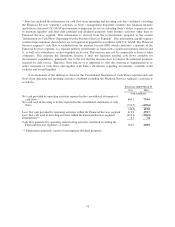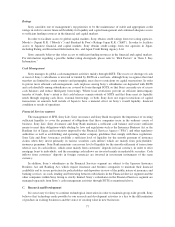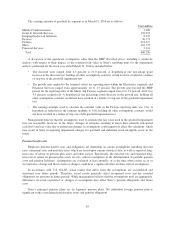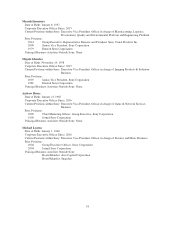Sony 2015 Annual Report Download - page 83
Download and view the complete annual report
Please find page 83 of the 2015 Sony annual report below. You can navigate through the pages in the report by either clicking on the pages listed below, or by using the keyword search tool below to find specific information within the annual report.Valuation of inventory
Sony values its inventory based on the lower of cost or market. Sony writes down inventory in an amount
equal to the difference between the cost of the inventory and the net realizable value — i.e., estimated selling
price in the ordinary course of business less reasonably predictable costs of completion and disposal. Sony writes
down the value of its inventory when the underlying parts, components or products have become obsolete, when
inventory levels exceed the amount expected to be used, or when the value of the inventory is otherwise recorded
at a higher value than net realizable value. As a result, if actual market conditions are less favorable than
projected and further price decreases are needed, additional inventory write-downs may be required in the future.
Impairment of long-lived assets
Sony reviews the recoverability of the carrying value of its long-lived assets held and used and long-lived
assets to be disposed of, whenever events or changes in circumstances indicate that the carrying value of the
assets or asset groups may not be recoverable. Long-lived assets to be held and used are reviewed for impairment
by comparing the carrying value of the asset or asset group with their estimated undiscounted future cash flows.
This review is primarily performed using estimates of future cash flows by product category (e.g. LCD
televisions) or, in certain cases, by entity. If the carrying value of the asset or asset group is considered impaired,
an impairment charge is recorded for the amount by which the carrying value of the asset or asset group exceeds
its fair value. Fair value is determined using the present value of estimated net cash flows or comparable market
values. This approach uses significant estimates and assumptions including projected future cash flows, the
timing of such cash flows, discount rates reflecting the risk inherent in future cash flows, perpetual growth rates
applied to determine terminal values, determination of appropriate market comparables and the determination of
whether a premium or discount should be applied to comparables.
Management believes that the estimates of future cash flows and fair value are reasonable; however,
changes in estimates resulting in lower future cash flows and fair value due to unforeseen changes in Sony’s
businesses or assumptions could negatively affect the valuations of long-lived assets.
Business combinations
When Sony applies the acquisition method of accounting, the deemed purchase price is allocated to
identifiable assets acquired and liabilities assumed. Any residual purchase price is recorded as goodwill. The
allocation of the purchase price utilizes significant estimates in determining the fair values of assets acquired and
liabilities assumed, especially with respect to intangible assets. Independent third-party appraisal firms are
typically engaged in order to assist in the estimation process. The significant estimates and assumptions include,
but are not limited to, the timing and amount of revenue and future cash flows, the discount rate reflecting the
risk inherent in future cash flows and the perpetual growth rate used to calculate the terminal value.
Due to the inherent uncertainties involved in making the estimates and assumptions, the purchase price for
acquisitions could be valued and allocated to the acquired assets and liabilities differently. Actual results may
differ, or unanticipated events and circumstances may affect such estimates, which could require Sony to record
an impairment of an acquired asset, including goodwill, or increase in the amounts recorded for an assumed
liability.
Goodwill and other intangible assets
Goodwill and indefinite lived intangible assets are tested annually for impairment during the fourth quarter
of the fiscal year and between annual tests if an event occurs or circumstances change that would more likely
than not reduce the fair value below its carrying amount. Such an event or change in circumstances would
include unfavorable variances from established business plans, significant changes in forecasted results or
volatility inherent to external markets and industries, which are periodically reviewed by Sony’s management.
In the fiscal year ended March 31, 2016, Sony elected not to perform an optional qualitative assessment of
goodwill and instead proceeded directly to a two-step quantitative impairment process which involves a
83
























